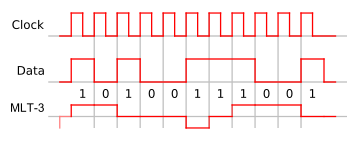
MLT-3 encoding
Encyclopedia

Line code
In telecommunication, a line code is a code chosen for use within a communications system for baseband transmission purposes...
(a signaling method used in a telecommunication
Telecommunication
Telecommunication is the transmission of information over significant distances to communicate. In earlier times, telecommunications involved the use of visual signals, such as beacons, smoke signals, semaphore telegraphs, signal flags, and optical heliographs, or audio messages via coded...
system for transmission purposes) that uses three voltage
Voltage
Voltage, otherwise known as electrical potential difference or electric tension is the difference in electric potential between two points — or the difference in electric potential energy per unit charge between two points...
levels. An MLT-3 interface emits less electromagnetic interference
Electromagnetic interference
Electromagnetic interference is disturbance that affects an electrical circuit due to either electromagnetic induction or electromagnetic radiation emitted from an external source. The disturbance may interrupt, obstruct, or otherwise degrade or limit the effective performance of the circuit...
and requires less bandwidth than most other binary
Boolean logic
Boolean algebra is a logical calculus of truth values, developed by George Boole in the 1840s. It resembles the algebra of real numbers, but with the numeric operations of multiplication xy, addition x + y, and negation −x replaced by the respective logical operations of...
or ternary
Ternary logic
In logic, a three-valued logic is any of several many-valued logic systems in which there are three truth values indicating true, false and some indeterminate third value...
interfaces that operate at the same bit rate
Bit rate
In telecommunications and computing, bit rate is the number of bits that are conveyed or processed per unit of time....
(see PCM for discussion on bandwidth / quantization
Quantization (signal processing)
Quantization, in mathematics and digital signal processing, is the process of mapping a large set of input values to a smaller set – such as rounding values to some unit of precision. A device or algorithmic function that performs quantization is called a quantizer. The error introduced by...
tradeoffs), such as Manchester code
Manchester code
In telecommunication and data storage, Manchester code is a line code in which the encoding of each data bit has at least one transition and occupies the same time...
or Alternate Mark Inversion
Bipolar encoding
In telecommunication, bipolar encoding is a type of line code . A duobinary signal is such an encoding.- Advantages :...
.
MLT-3 cycles sequentially through the voltage levels -1, 0, +1. It moves to the next state to transmit a 1 bit, and stays in the same state to transmit a 0 bit. Similar to simple NRZ
Non-return-to-zero
In telecommunication, a non-return-to-zero line code is a binary code in which 1's are represented by one significant condition and 0's are represented by some other significant condition , with no other neutral or rest condition. The pulses have more energy than a RZ code...
encoding, MLT-3 has a coding efficiency of 1 bit/baud, however it requires four transitions (baud) to complete a full cycle (from low-to-middle, middle-to-high, high-to-middle, middle-to-low). Thus, the maximum fundamental frequency is reduced to one fourth of the baud rate. This makes signal transmission more amenable to copper wires.
MLT-3 was first introduced by Crescendo Communications as a coding scheme for FDDI copper interconnect (TP-PMD, aka CDDI). Later, the same technology was used in the 100BASE-TX physical medium dependent sublayer, given the considerable similarities between FDDI and 100BASE-[TF]X
Fast Ethernet
In computer networking, Fast Ethernet is a collective term for a number of Ethernet standards that carry traffic at the nominal rate of 100 Mbit/s, against the original Ethernet speed of 10 Mbit/s. Of the fast Ethernet standards 100BASE-TX is by far the most common and is supported by the...
physical media attachment layer (section 25.3 of IEEE802.3-2002 specifies that ANSI X3.263:1995 TP-PMD should be consulted, with minor exceptions).
Signaling specified by 100BASE-T4 Ethernet, while it has three levels, is not compatible with MLT-3. It uses selective base-2
Binary numeral system
The binary numeral system, or base-2 number system, represents numeric values using two symbols, 0 and 1. More specifically, the usual base-2 system is a positional notation with a radix of 2...
to base-3
Ternary numeral system
Ternary is the base- numeral system. Analogous to a bit, a ternary digit is a trit . One trit contains \log_2 3 bits of information...
conversion with direct mapping of base-3 digits to line levels (8B6T code).

